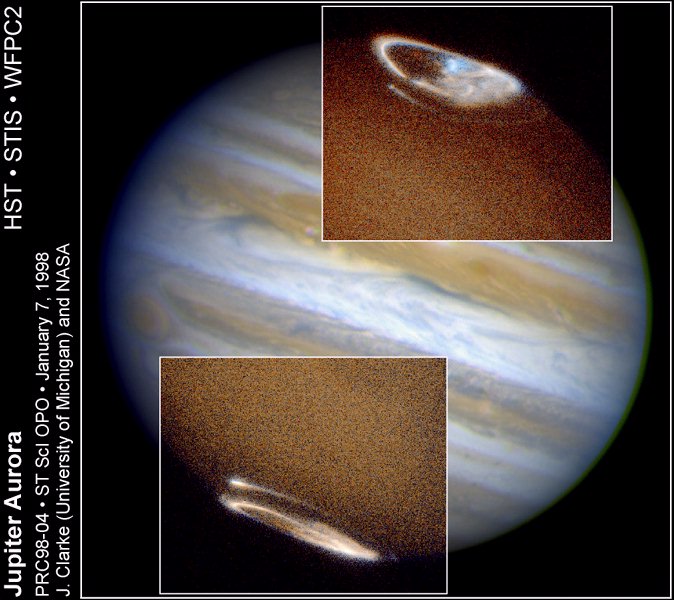
FOR RELEASE: January 7, 1998
PHOTO NO.: STScI-PRC98-04

NASA's Hubble Space Telescope has captured a complete view
of Jupiter's northern and southern auroras.
Images taken in ultraviolet light by the Space Telescope
Imaging Spectrograph (STIS) show both auroras, the oval-shaped objects in the inset photos. While the Hubble
telescope has obtained images of Jupiter's northern and
southern lights since 1990, the new STIS instrument is 10
times more sensitive than earlier cameras. This allows for
short exposures, reducing the blurring of the image caused
by Jupiter's rotation and providing two to five times higher
resolution than earlier cameras. The resolution in these
images is sufficient to show the "curtain" of auroral light
extending several hundred miles above Jupiter's limb (edge).
Images of Earth's auroral curtains, taken from the space
shuttle, have a similar appearance. Jupiter's auroral images
are superimposed on a Wide Field and Planetary Camera 2
image of the entire planet. The auroras are brilliant
curtains of light in Jupiter's upper atmosphere. Jovian
auroral storms, like Earth's, develop when electrically
charged particles trapped in the magnetic field surrounding
the planet spiral inward at high energies toward the north
and south magnetic poles. When these particles hit the upper
atmosphere, they excite atoms and molecules there, causing
them to glow (the same process acting in street lights).
The electrons that strike Earth's atmosphere come from the
sun, and the auroral lights remain concentrated above the
night sky in response to the "solar wind," as Earth
rotates underneath. Earth's auroras exhibit storms that
extend to lower latitudes in response to solar activity,
which can be easily seen from the northern U. S. But
Jupiter's auroras are caused by particles spewed out by
volcanoes on Io, one of Jupiter's moons. These charged
particles are then magnetically trapped and begin to rotate
with Jupiter, producing ovals of auroral light centered on
Jupiter's magnetic poles in both the day and night skies.
Scientists are comparing the Hubble telescope images with
measurements taken by NASA's Galileo spacecraft of Jupiter's
magnetic field and co-rotating charged particles. They
believe the data will help them understand the production of
Jupiter's auroras.
Both auroras clearly show vapor trails of light left by Io.
These vapor trails are the white, comet-shaped streaks just
outside both auroral ovals. These streaks are not part of
the auroral ovals. They are caused when an invisible
electrical current of charged particles (equal to about 1
million amperes), ejected from Io, flow along Jupiter's
magnetic field lines to the planets north and south magnetic
poles. This enormous current produces a bright but localized
aurora where it enters Jupiter's atmosphere at both magnetic
poles. The brightest part of both emissions (on the left in
both images) pinpoints where Io's magnetic field lines leave
its footprint on the planet. The trail of light following
both emissions extends to the right all the way to Jupiter's
edge and represents the most sensitive detection of
ultraviolet emissions from Jupiter to date. These emissions
are related to magnetically trapped ions and electrons that
are carried by Jupiter's magnetic field along Io's orbital
path, and some of these charged particles continue to be
driven down into Jupiter's atmosphere for several hours
after Io has passed by.
The images were taken Sept. 20, 1997. The artificial colors
used here have been constructed by combining images taken in
two different ultraviolet band passes, with one ultraviolet
color presented as blue and the other as red. In this color
representation, the planet's reflected sunlight appears
brown, while the auroral emissions appear white or shades of
blue or red.
Credits: John Clarke (University of Michigan), and NASA
Co-investigators: Joe Ajello, Kent Tobiska, and John
Trauger (NASA's Jet Propulsion Laboratory)
Gilda Ballester (University of Michigan)
Lotfi Ben jaffel (IAP Paris)
Jack Connerney (NASA's Goddard Space Flight Center)
Jean-Claude Gerard (University of Liege, Belgium)
Randy Gladstone and Hunter Waite (Southwest
Research Institute)
Wayne Pryor (University of Colorado)
Daniel Rego (University College, London)